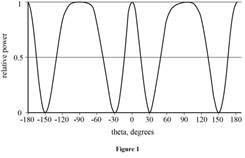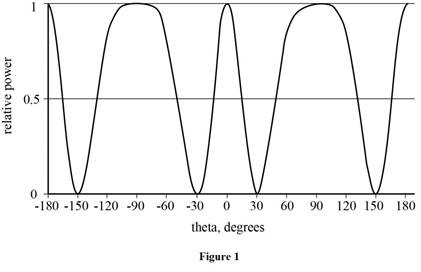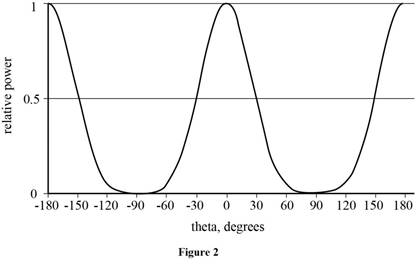
Concept explainers
(a)
Whether the power detected at
(a)
Answer to Problem 61P
The power detected at
Explanation of Solution
It is given that the radio waves have the same frequency and start out in phase. This implies the radio waves are coherent. When two coherent waves are in phase, their superposition will result in constructive interference.
All the points on the
(b)
The graph of
(b)
Answer to Problem 61P
The qualitative graph showing the variation of power with the angle is

Explanation of Solution
The given situation can be treated as a double-slit problem with the antennas playing the role of the slits.
Write the condition for the maxima.
Here,
It is given that
Replace
The values of
Substitute
Substitute
Thus the directions between
Write the equation for the minima.
Replace
Substitute
The qualitative graph is shown in figure 1.

Conclusion:
Thus, the graph of
(c)
The graph of
(c)
Answer to Problem 61P
The qualitative graph for

Explanation of Solution
Replace
Substitute
Replace
Substitute
The qualitative graph is shown in figure 2.

Conclusion:
Thus, the graph of
Want to see more full solutions like this?
Chapter 25 Solutions
Loose Leaf For Physics With Connect 2 Semester Access Card
 College PhysicsPhysicsISBN:9781305952300Author:Raymond A. Serway, Chris VuillePublisher:Cengage Learning
College PhysicsPhysicsISBN:9781305952300Author:Raymond A. Serway, Chris VuillePublisher:Cengage Learning University Physics (14th Edition)PhysicsISBN:9780133969290Author:Hugh D. Young, Roger A. FreedmanPublisher:PEARSON
University Physics (14th Edition)PhysicsISBN:9780133969290Author:Hugh D. Young, Roger A. FreedmanPublisher:PEARSON Introduction To Quantum MechanicsPhysicsISBN:9781107189638Author:Griffiths, David J., Schroeter, Darrell F.Publisher:Cambridge University Press
Introduction To Quantum MechanicsPhysicsISBN:9781107189638Author:Griffiths, David J., Schroeter, Darrell F.Publisher:Cambridge University Press Physics for Scientists and EngineersPhysicsISBN:9781337553278Author:Raymond A. Serway, John W. JewettPublisher:Cengage Learning
Physics for Scientists and EngineersPhysicsISBN:9781337553278Author:Raymond A. Serway, John W. JewettPublisher:Cengage Learning Lecture- Tutorials for Introductory AstronomyPhysicsISBN:9780321820464Author:Edward E. Prather, Tim P. Slater, Jeff P. Adams, Gina BrissendenPublisher:Addison-Wesley
Lecture- Tutorials for Introductory AstronomyPhysicsISBN:9780321820464Author:Edward E. Prather, Tim P. Slater, Jeff P. Adams, Gina BrissendenPublisher:Addison-Wesley College Physics: A Strategic Approach (4th Editio...PhysicsISBN:9780134609034Author:Randall D. Knight (Professor Emeritus), Brian Jones, Stuart FieldPublisher:PEARSON
College Physics: A Strategic Approach (4th Editio...PhysicsISBN:9780134609034Author:Randall D. Knight (Professor Emeritus), Brian Jones, Stuart FieldPublisher:PEARSON





